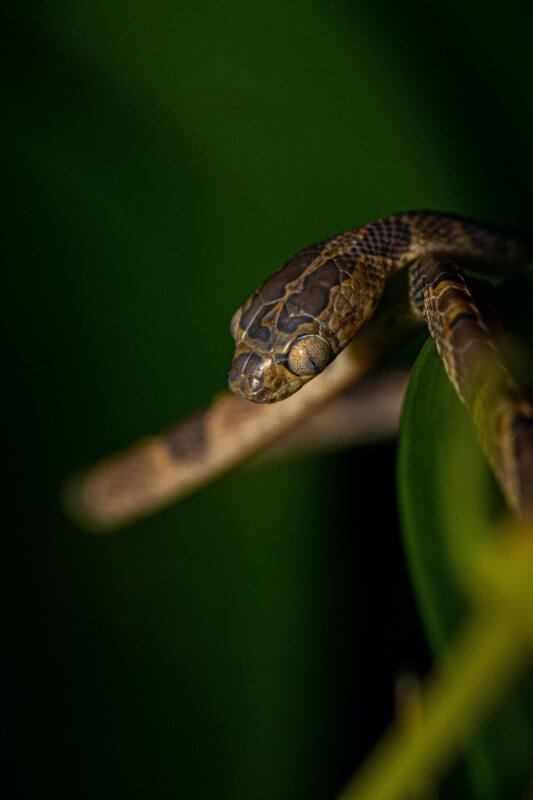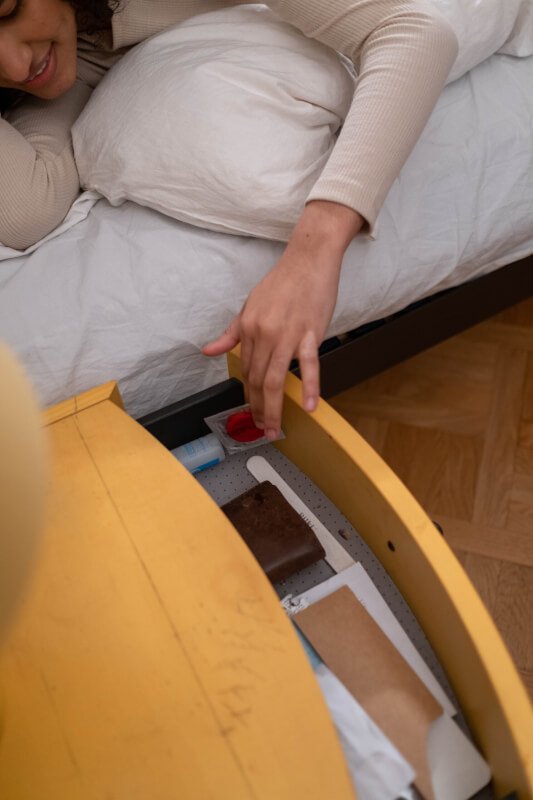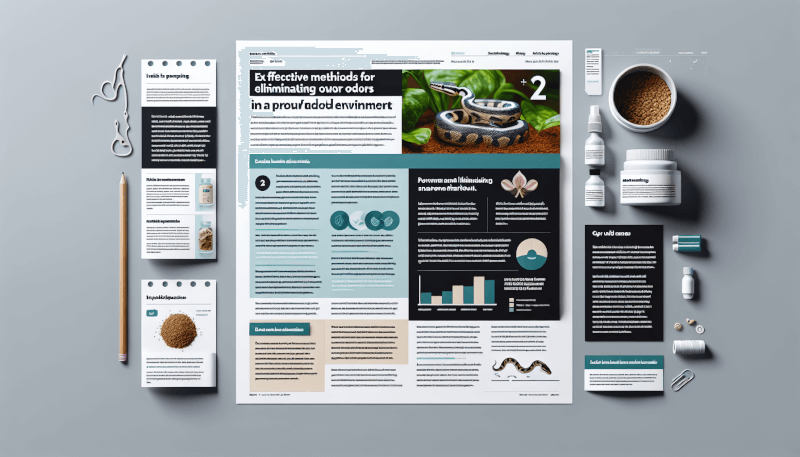In the world of reptile enthusiasts, snake owners are well aware that maintaining a clean and odor-free habitat is essential for the overall health and well-being of their scaly companions. Whether you’re a seasoned snake owner or a newcomer to the world of serpents, finding the best ways to prevent and eliminate odor in your snake’s habitat is crucial to ensure a pleasant living environment for both you and your slithery friend. In this article, we will explore some simple yet effective techniques that will help you keep your snake’s habitat fresh and odor-free, allowing you to enjoy your reptilian companion to the fullest.

Choosing the Right Substrate
When it comes to choosing the right substrate for your snake’s habitat, there are a few key factors to consider. First and foremost, you’ll want to use odor-absorbing substrates. Snakes naturally produce waste, and this waste can contribute to unpleasant odors if not properly managed. By using a substrate that has odor-absorbing properties, you can help to minimize the smell in your snake’s enclosure.
In addition to odor absorption, it’s also important to avoid using substrates that retain moisture. Snakes prefer dry environments, so using a substrate that holds a lot of moisture can create a breeding ground for bacteria and contribute to foul odors. Opt for substrates that allow for proper airflow and help to keep the enclosure dry.
Consider using natural substrates as well. Materials such as cypress mulch, aspen shavings, or even newspaper can be great options for snake habitats. These substrates are not only odor-absorbing and moisture-reducing but also mimic the snake’s natural environment.
Maintaining Proper Ventilation
Proper ventilation is essential for keeping odors at bay in your snake’s habitat. Ensuring that there is adequate airflow in the enclosure helps to prevent the buildup of stagnant air and allows for better odor control. You can achieve this by selecting an enclosure that has adequate ventilation built-in or by using ventilation systems or fans.
When setting up the enclosure, make sure to position it in a well-ventilated area of your home. Avoid placing it in a closed-off room with poor air circulation. If needed, you can also utilize fans or small air circulation devices to promote airflow within the enclosure. Regularly inspect the enclosure to ensure that the ventilation system is functioning properly and unclog any vents if necessary.
Regular Cleaning and Maintenance
Regular cleaning and maintenance are crucial for preventing and eliminating odor in your snake’s habitat. One of the most important steps you can take is to remove waste promptly. This means regularly checking the enclosure for any feces, shed skin, or leftover food and promptly removing it. Regular spot cleaning can go a long way in preventing odors from building up.
In addition to spot cleaning, it’s necessary to clean the entire enclosure regularly. This should include removing any soiled substrate, wiping down the surfaces, and disinfecting as needed. The frequency of full cleanings may vary depending on the size of the enclosure and the type of substrate used, but a general rule of thumb is to deep clean every four to six weeks.
When disinfecting the enclosure, be sure to use a reptile-safe disinfectant. Follow the instructions provided by the manufacturer and thoroughly rinse and dry the enclosure before reintroducing your snake.
Proper Feeding and Waste Management
Proper feeding practices play a significant role in managing the odor in your snake’s habitat. It’s important to feed your snake appropriately and avoid overfeeding. If snakes are fed more than they need, it can result in excess waste and odors. Follow a feeding schedule recommended for your specific snake species and monitor their body condition to ensure they are receiving the proper amount of food.
When it comes to waste management, it’s essential to handle and dispose of waste properly. Use designated feeding containers or areas to minimize the potential for spills or contamination. After feeding, remove any uneaten prey and properly dispose of it. Regularly clean and disinfect feeding containers or areas to prevent bacterial growth and odors.

Controlling Humidity Levels
Maintaining appropriate humidity levels is essential for your snake’s wellbeing and can also help control odors. Snakes have varying humidity requirements depending on their species and natural habitats. It’s crucial to monitor and regulate humidity levels within the enclosure to prevent excessive moisture that can lead to odor-causing bacteria.
To monitor humidity, use a hygrometer, a device specifically designed to measure humidity levels. This will allow you to ensure that the humidity is within the appropriate range for your snake. If the humidity is too high, consider using a dehumidifier or adjusting the amount of water provided in the enclosure. Conversely, if the humidity is too low, incorporate methods to increase humidity such as misting the enclosure or using a humidifier.
Using Odor Neutralizers and Absorbers
In addition to proper substrate choice and regular maintenance, utilizing odor neutralizers and absorbers can help combat any lingering odors in your snake’s habitat. Odor neutralizing sprays that are safe for reptiles can be applied to the enclosure to help eliminate unpleasant smells. These sprays work by neutralizing odor-causing molecules rather than simply masking them.
Another option is to place odor absorbers in the enclosure. Activated carbon, baking soda, or even charcoal briquettes can help absorb and minimize odors. Simply place the odor absorbers in a corner or discreet area of the enclosure, and they will work to absorb any odors over time.

Identifying and Addressing Health Issues
Sometimes, odors in your snake’s enclosure can indicate underlying health issues. It’s crucial to monitor your snake for any signs of illness or infection that may be contributing to the odor. Keep an eye out for symptoms such as abnormal behavior, loss of appetite, respiratory difficulties, or changes in skin appearance.
If you notice any concerning signs, it’s essential to seek veterinary care promptly. A qualified reptile veterinarian will be able to diagnose and treat any health issues your snake may be experiencing. Timely intervention can help address any odors caused by illness and ensure your snake’s overall well-being.
Enclosure Design Considerations
The design of your snake’s enclosure can also impact the odors present within it. Choosing an appropriate size for your snake is crucial. The enclosure should be large enough for your snake to move around comfortably, but not so large that it becomes difficult to maintain proper temperature and humidity levels.
Additionally, providing hiding spots in the enclosure can help reduce stress for your snake. These hiding spots can be created using various objects such as branches, rocks, or commercially available reptile hides. When a snake feels secure and less stressed, it is less likely to release stress-related odors.
Remember to regularly inspect and assess the enclosure design to ensure that it is serving the needs of your snake. Make any necessary adjustments or additions to promote a healthy and odor-free living environment.

Quarantine and Isolation Practices
When introducing new snakes into your collection, it’s important to practice quarantine and isolation to prevent the spread of potential diseases or parasites. Quarantining a new snake involves keeping it separate from your existing snakes for a period of time to allow for observation and any necessary treatments. This helps to ensure the health and safety of both the new snake and the rest of your collection.
Similarly, if you notice that one of your snakes is exhibiting signs of illness or infection, it’s important to isolate that snake from the others. This can help contain the potential spread of any contagious diseases and minimize the impact on the overall health of your collection.
Educating Yourself and Seeking Expert Advice
One of the best ways to ensure that you are effectively managing odors in your snake’s habitat is to educate yourself about the specific needs of your snake species. Different snake species have different odor-related requirements, and knowing these specific details will help you make informed decisions about substrate choices, feeding practices, and habitat design.
Seeking advice from experienced snake keepers or herpetologists can also provide valuable insights. These individuals have years of hands-on experience with reptiles and can offer guidance tailored to your specific situation. Don’t hesitate to reach out to local reptile clubs, forums, or reputable breeders for advice and support.
By following these best practices, you can provide your snake with a clean, odor-free habitat that will contribute to their overall health and well-being. Taking the time to choose the right substrate, maintain proper ventilation, clean regularly, and address waste management will help create a comfortable living environment for your snake. Remember, ongoing monitoring and education are key to ensuring that you are providing the best care for your scaly friend.



